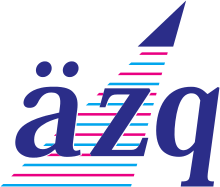German Agency for Quality in Medicine
The German Agency for Quality in Medicine (AEZQ) - in German "Ärztliches Zentrum für Qualität in der Medizin (ÄZQ)", established in 1995 and located in Berlin, co-ordinates healthcare quality programmes with special focus on evidence-based medicine, medical guidelines, patient empowerment, patient safety programs, and quality management.[1]
 | |
| Formation | 1995 |
|---|---|
| Type | German NPO |
| Purpose | Promoting Evidence based Health care, Patient Safety & Medical Guidelines |
| Headquarters | Berlin, Germany |
Region served | Germany |
Chairman | Frank Ulrich Montgomery & Andreas Gassen |
Parent organization | German Medical Association & Nat. Ass. for Statutory Health Insurance Physicians |
| Affiliations | Guidelines International Network, German Network for Evidence Based Medicine |
| Website | www.aezq.de |
AEZQ is a non-profit organization owned by the German Medical Association and the National Association of Statutory Health Insurance Physicians.[2]
Activities
AEZQ initiated several quality programs for the German healthcare system:
It established the German Program for evidence based medical guidelines in the late 90s. Based upon guideline standards from the Scottish Intercollegiate Guideline Network and referring to experiences from the National Guideline Clearinghouse in the US, the agency founded a German Guideline Clearinghouse[3] aiming at best practice in guideline production.[4]
In 1998 AEZQ was co-founder of the German Network for Evidence Based Medicine.
The organization established the German Clearinghouse for Patient Information[5] in order to promote scientifically based shared decision making[6] in 1999.
In 2002, the agency set up the National Program for Disease Management Guidelines.[7][8]
The development of reliable and consumer information is integral part of this guideline program.[9]
AEZQ was co-founder of the Guidelines International Network in 2002 - under the leadership of Günter Ollenschläger, collaborating with other national healthcare quality agencies like the US Agency for Healthcare Research and Quality, the UK National Institute for Health and Clinical Excellence, the Australian National Health and Medical Research Council.[10]
In the field of patient safety AEZQ was one of the first German organisations calling for effective patient safety programs.[11] The agency was co-founder of the German Coalition for Patient Safety. AEZQ established a national network of Critical Incident Reporting Systems.[12][13] The institution is partner of the international High 5 Project.
In 2010 the agency set up a Digital Library for physicians and other interested health professionals and lays - the German Medical eLibrary (www.arztbibliothek.de) - for reinforcement of reliable and unbiased knowledge management in healthcare.[14]
AEZQ entertained the administrative offices of the Guidelines International Network, and of the German Network for Evidence Based Medicine until 2013. It hosts the editorial office of the German Journal for Evidence and Quality in Healthcare ZEFQ.
References
- World Health Organization - Europe. Health Evidence Network (HEN). Technical Members: German Agency for Quality in Medicine
- Legido-Quigley, Helena; McKee, Martin; Nolte, Ellen; Glinos, Irene A (2008). "Germany". Assuring the quality of health care in the European Union: A case for action (PDF). World Health Organization. pp. 116–20. ISBN 978-92-890-7193-2.
- Ollenschläger, G.; Kirchner, H.; Oesingmann, U.; Kolkmann, F. W.; Kunz, R. (2001). "The German Guidelines Clearing house (GGC) – rationale, aims and results" (PDF). Proceedings of the Royal College of Physicians of Edinburgh. 31 (Supplement 9): 59–64.
- Council of Europe (2002). Developing a methodology for drawing up guidelines on best medical practice (PDF). Strasbourg: Council of Europe Publishing. pp. 46–47. ISBN 978-92-871-4788-2.
- Sänger, S; Nickel, J; Huth, A; Ollenschläger, G (2002). "Gut informiert über Gesundheitsfragen, aber wie? - Das Deutsche Clearingverfahren für Patienteninformationen - Zielsetzung, Hintergrund und Arbeitsweise" [Well-informed on health matters--how well? The German 'Clearinghouse for Patient Information'--objective, background and methods]. Das Gesundheitswesen (in German). 64 (7): 391–7. doi:10.1055/s-2002-32812. PMID 12119584.
- Delbanco, T; Berwick, DM; Boufford, JI; Edgman-Levitan, S; Ollenschläger, G; Plamping, D; Rockefeller, RG (2001). "Healthcare in a land called PeoplePower: nothing about me without me". Health Expectations. 4 (3): 144–50. doi:10.1046/j.1369-6513.2001.00145.x. PMC 5060064. PMID 11493320.
- Ollenschläger, Günter; Kopp, Ina (2007). "Nationale VersorgungsLeitlinien von BÄK, AWMF und KBV" [The German program for disease management guidelines. Results and perspectives]. Medizinische Klinik (in German). 102 (5): 383–7. doi:10.1007/s00063-007-1052-1. PMID 17497089.
- Weinbrenner, Susanne; Conrad, Susann; Weikert, Beate; Kopp, Ina (2010). "7 Jahre Nationale VersorgungsLeitlinien (NVL) - Quo vadis?" [After seven years of National Disease Management Guidelines: quo vadis?]. Zeitschrift für Evidenz, Fortbildung und Qualität im Gesundheitswesen (in German). 104 (7): 533–9. doi:10.1016/j.zefq.2010.07.010. PMID 21095605.
- Schaefer, Corinna; Kirschning, Silke (2010). "Gut informiert entscheiden: Patienten- und Verbraucherinformationen am ÄZQ" [Informed decisions: patient and consumer information at the German Agency for Quality in Medicine (ÄZQ)]. Zeitschrift für Evidenz, Fortbildung und Qualität im Gesundheitswesen (in German). 104 (7): 578–84. doi:10.1016/j.zefq.2010.09.001. PMID 21095611.
- Ollenschlager, G; Marshall, C; Qureshi, S; Rosenbrand, K; Burgers, J; Mäkelä, M; Slutsky, J; Board of Trustees 2002, Guidelines International Network (G-I-N) (2004). "Improving the quality of health care: using international collaboration to inform guideline programmes by founding the Guidelines International Network (G-I-N)". Quality and Safety in Health Care. 13 (6): 455–60. doi:10.1136/qhc.13.6.455. PMC 1743909. PMID 15576708.
- Ollenschläger, G. (2001), "Medizinische Risiken, Fehler und Patientensicherheit. Zur Situation in Deutschland" (PDF), Schweizerische Ärztezeitung (in German), 82 (26): 1404–10, doi:10.4414/saez.2001.08273, archived from the original (PDF) on 22 March 2012
- Hoffmann, Barbara; Rohe, Julia (2010). "Patient Safety and Error Management—What Causes Adverse Events and How Can They Be Prevented?". Deutsches Ärzteblatt International. 107 (6): 92–9. doi:10.3238/arztebl.2010.0092. PMC 2832110. PMID 20204120.
- Rohe, Julia; Heinrich, Andrea Sanguino; Fishman, Liat; Renner, Daniela; Thomeczek, Christian (2010). "15 Jahre ÄZQ – 10 Jahre Patientensicherheit am ÄZQ" [After 15 years of ÄZQ: 10 years of safety for patients]. Zeitschrift für Evidenz, Fortbildung und Qualität im Gesundheitswesen (in German). 104 (7): 563–71. doi:10.1016/j.zefq.2010.08.002. PMID 21095609.
- Rütters, Dana; Schwencke, Silja; Bunk, Thomas; Nothacker, Monika (2010). "Die Arztbibliothek" [The German Medical eLibrary]. Zeitschrift für Evidenz, Fortbildung und Qualität im Gesundheitswesen (in German). 104 (7): 585–90. doi:10.1016/j.zefq.2010.07.005. PMID 21095612.